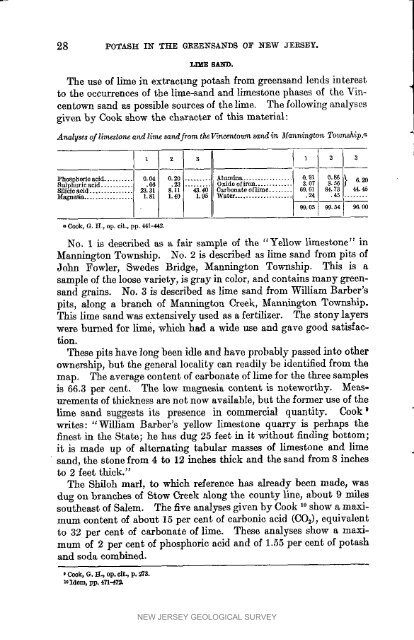Bulletin 23. Potash in the Greensands of NJ, 1923 - State of New ...
Bulletin 23. Potash in the Greensands of NJ, 1923 - State of New ...
Bulletin 23. Potash in the Greensands of NJ, 1923 - State of New ...
Create successful ePaper yourself
Turn your PDF publications into a flip-book with our unique Google optimized e-Paper software.
28 POTASH Ii_ THE GREENSAlXTDS OF NEW JERSEY.<br />
SAND.<br />
The use <strong>of</strong> lime <strong>in</strong> extrae_mg potash from greensand lends <strong>in</strong>terest<br />
to <strong>the</strong> occurrences <strong>of</strong> <strong>the</strong> lime-sand and limestone phases <strong>of</strong> <strong>the</strong> V<strong>in</strong>centown<br />
sand as possible sources <strong>of</strong> <strong>the</strong> lime. The follow<strong>in</strong>g analyses<br />
giwn by Cook show <strong>the</strong> character <strong>of</strong> this material:<br />
Analyses <strong>of</strong> limestone and lirae sand from <strong>the</strong> _ncer_oum 8and <strong>in</strong> Mann<strong>in</strong>gton Townsh_p.a<br />
1 2 3 1 2 3<br />
?hc_phorlcacid .......... 0.04 I 0.20 ......... Atum<strong>in</strong>a ................ _}.91 0._6 6.20<br />
]ulphuric acid ............ 06 .23 ......... O_ido <strong>of</strong> iron ............. 9.97 3.56<br />
]Siclc _eid ............... <strong>23.</strong>31 8.11 43.49 Carbonate <strong>of</strong>llm¢ ........ 69.91 84.73 44.45<br />
_agnesia ................. 1.81 1.40 1.95 Water ..................... 24 .45 ........<br />
99.05 99.54 96. O9<br />
a Cook, O. H._ op. cir., pp. 441-442.<br />
No. I is described as a fair sample <strong>of</strong> <strong>the</strong> "Yellow limestone" <strong>in</strong><br />
Mann<strong>in</strong>gton Township. No. 2 is described as lime sand from pits <strong>of</strong><br />
John Fowler, Swedes Bridge, Mann<strong>in</strong>gton Township. This is a<br />
sample <strong>of</strong> <strong>the</strong> loose variety, is gray <strong>in</strong> color, and conta<strong>in</strong>s many greensand<br />
gra<strong>in</strong>s. No. 3 is described as lime sand from William Barber's<br />
pits, along a branch <strong>of</strong> Manniugtoa Creek, Mann<strong>in</strong>gt_n Township.<br />
This lime sand was extensively used as a fertilizer. The stony layers<br />
were burned for lime, which had a wide use and gave good satisfaction.<br />
These pits have long been idle and have probably passed <strong>in</strong>to o<strong>the</strong>r<br />
ownership, but <strong>the</strong> general locality can readily be identified from <strong>the</strong><br />
map. The average content <strong>of</strong> carbonate <strong>of</strong> lime for <strong>the</strong> three samples<br />
is 66.3 per cent. The low mugnesia content is noteworthy. Measurements<br />
<strong>of</strong> thickness are not now available, but <strong>the</strong> former use <strong>of</strong> <strong>the</strong><br />
lime sand suggests its presence <strong>in</strong> commercial quantity. Cook'<br />
writes: "William Barber's yellow limestone quarry is perhaps <strong>the</strong><br />
f<strong>in</strong>est <strong>in</strong> <strong>the</strong> <strong>State</strong>; he has dug 25 feet <strong>in</strong> it without f<strong>in</strong>d<strong>in</strong>g bottom;<br />
it is made up <strong>of</strong> alternat<strong>in</strong>g tabular masses <strong>of</strong> limestone and lime<br />
sand, <strong>the</strong> stone from 4 to 12 <strong>in</strong>ches thick and <strong>the</strong> sand from 8 <strong>in</strong>ches<br />
to 2 feet thick."<br />
The Shiloh marl, to which reference has already been made, was<br />
dug on branches <strong>of</strong> Stow Creek along <strong>the</strong> county l<strong>in</strong>e, about 9 miles<br />
sou<strong>the</strong>ast <strong>of</strong> Salem. The five analyses given by Cook ,o show a maximum<br />
content <strong>of</strong> about 15 per cent <strong>of</strong> carbonic acid (CO_), equivalent<br />
to 32 per cent <strong>of</strong> carbonate <strong>of</strong> lime. These analyses show a maximum<br />
<strong>of</strong> 2 per cent <strong>of</strong> phosphoric acid and <strong>of</strong> 1.55 per cent <strong>of</strong> potash<br />
and soda comb<strong>in</strong>ed.<br />
'Cock, O. ]_.j op. eat., p. _73.<br />
_ Ide_3, pp, 471--4_<br />
NEW JERSEY GEOLOGICAL SURVEY

















